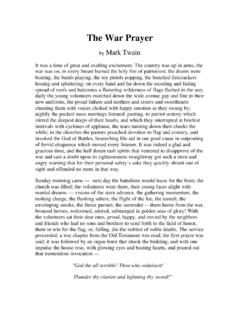Transcription of CHAPTER 1: INTRODUCTION TO LAW AND LEGAL …
1 1 CHAPTER 1: INTRODUCTION TO LAW AND LEGAL REASONING LAW IS "MAN MADE" IT CHANGES OVER TIME TO ACCOMMODATE SOCIETY'S NEEDS LAW IS MADE BY LEGISLATURE LAW IS INTERPRETED BY COURTS TO DETERMINE 1)WHETHER IT IS "CONSTITUTIONAL" 2)WHO IS RIGHT OR WRONG THERE IS A PROCESS WHICH MUST BE FOLLOWED (CALLED "PROCEDURAL LAW") I. Thomas Jefferson: "The study of the law qualifies a man to be useful to himself, to his neighbors, and to the public." II. Ask Several Students to give their definition of "Law.
2 " A. Even after years and thousands of dollars, "LAW" still is not easy to define B. What does law Consist of ? Law consists of enforceable rule governing relationships among individuals and between individuals and their society. 1. Students Need to Understand. a. The law is a set of general ideas b. When these general ideas are applied, a judge cannot fit a case to suit a rule; he must fit (or find) a rule to suit the unique case at hand. c. The judge must also supply legitimate reasons for his decisions.
3 C. So, How was the Law Created. The law considered in this text are "man made" law. This law can (and will) change over time in response to the changes and needs of society. D. Example. Grandma, who is 87 years old, walks into a pawn shop. She wants to sell her ring that has been in the family for 200 years. Grandma asks the dealer, "how much will you give me for this ring." The dealer, in good faith, tells Grandma he doesn't know what kind of metal is in the ring, but he will give her $150.
4 1. Grandma needs cash to buy medicine and therefore accepts the $150. 2. The ring turns out to be solid gold and is really worth $25,000. 3. Question. Can Grandma get the ring back or recover the difference between 25,000 and 150 or is she merely out of look. a. Ask was there a bargain for exchange b. Was the ring purchased in good faith without knowledge of its value THIS IS WHAT WE WILL ENCOUNTER IN THIS COURSE 2 III. Schools of LEGAL Thought. A. Background. When we look at the development of law, there are several things they have had a major influence.
5 Some of the more important element are customs, history, and logic. B. The "Problem". The major problem is that philosophers disagree on what are the major factors. C. Outcome. This disagree has lead to 2 different schools of thought on what the major factors are: 1. The Traditional Approach. The first school of thought is the "traditional approach." The traditional approach looks to the past to discover what the principles of the current law should be.
6 A. Strict Decisions are followed. Followers of this school look to prior decisions which are on point and will usually follow them to the letter. b. Example. Homer left the neighbor's house and was obviously intoxicated. The neighbor knew Homer was intoxicated but kept serving him drinks and then allowed him to drive. Homer lost control of his car and killed a 6 year old child. Homer has no money or insurance. (1) The child's parents want to sue the "Neighbor" for negligence as a social host.
7 (2) Case Was recently decided stating that social host are not liable for their guest. (3) Under the traditional approach, parents lose. The court will follow prior decisions. 2. The Sociological Approach. The second school of thought is called the "sociological approach." Under this approach, social forces and needs are the primary factors. a. The key to this approach is that historical cases don't drive future law. Under this approach, as society changes, the law should also change.
8 B. Earlier Illustrated Case. Under this approach, the social host issue would probably have a different outcome (1) Why? Because the court would see this as a public safety issue and would put the (1) put the burden on individuals contributing to the occurrence and (2) provide a financial outlet for those who have been injured. IV. COMMON LAW. A. Background. First, common law is still alive and well in many aspects. This is the law that is common to the entire realm or population.
9 1. As the text states, common law includes some aspects of statutory and case law dating back prior to the American Revolution. a. What is Case Law. Case law is merely the rules of law announced in court decisions. Case law may consist of interpretations of statutes, regulations and provisions in the 3 constitution. (1) You will hear the terms "precedent" and "stare decisis" when case law is discussed. (A) Precedent is merely a prior case which is similar in LEGAL principle or fact.
10 (B) Stare Decisis is the practice of deciding new cases with reference to former cases. b. What is Statutory Law. In its simplest terms, statutory law consists laws enacted by state legislatures and at the federal level, by Congress Example 1: Rape Statutes. Example 2: Divorce Statutes Example 3: Business Incorporation Statutes III. REASONING A. Background. A judge cannot merely render an opinion on an issue and stop there. He must articulate a legitimate reason why he has ruled in such a manner.





![[Music] My name is Zeena Simmons. I am a senior](/cache/preview/b/e/3/2/0/2/e/e/thumb-be3202ee2da9d277f5539b5043c10f43.jpg)









